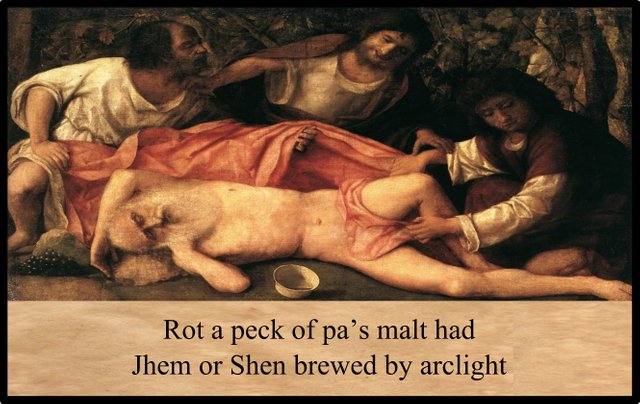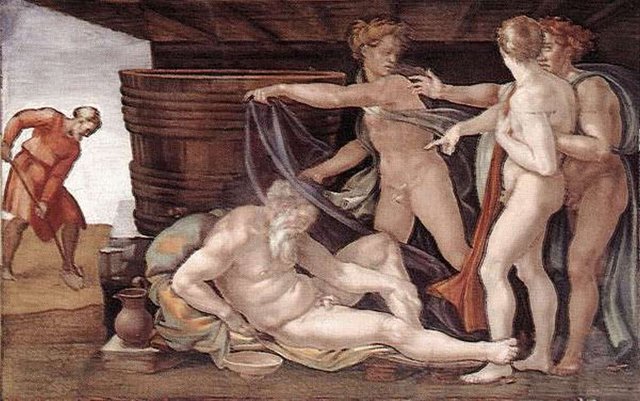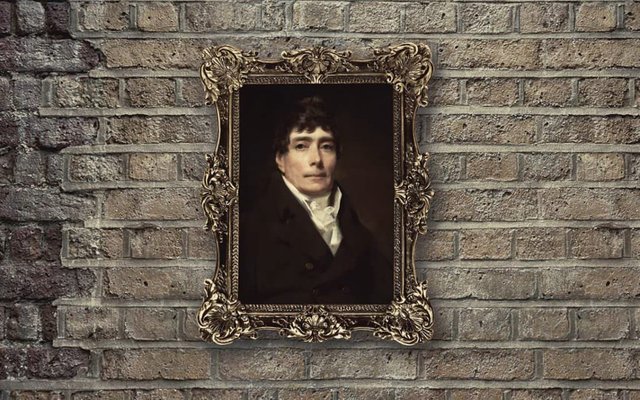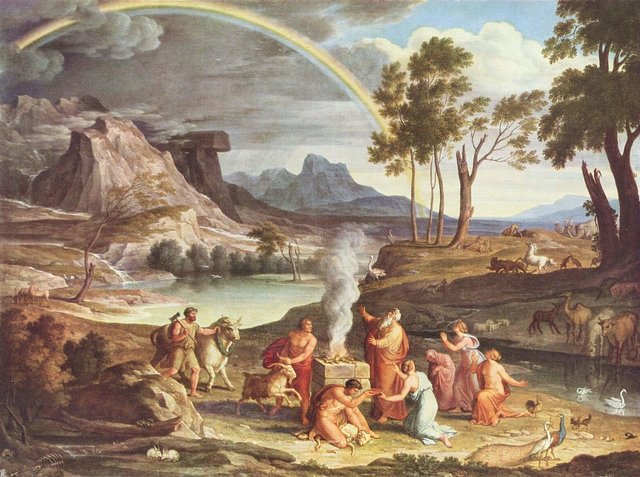Rot a Peck of Pa’s Malt

In the penultimate clause of the second paragraph of Finnegans Wake, James Joyce once again blends Biblical imagery with Irish history, something he did in the four preceding clauses. This time, however, the Biblical theme was not obviously present in the first draft:
Not a peck of malt had Shem and Son brewed. (Hayman 46)
But the following drafts removed any doubt:
Rot a peck of pa’s malt had Hem or Sen brewed by arclight. (Hayman 46)
The final version clarified the allusion to the Dublin whiskey distiller John Jameson & Son, while not undermining the Noachic elements.

The Drunkenness of Noah
The Biblical passage that informs this clause is the story of the Drunkenness of Noah in the Book of Genesis:
And the sons of Noah, that went forth of the ark, were Shem, and Ham, and Japheth: and Ham is the father of Canaan. These are the three sons of Noah: and of them was the whole earth overspread. And Noah began to be an husbandman, and he planted a vineyard: And he drank of the wine, and was drunken; and he was uncovered within his tent. And Ham, the father of Canaan, saw the nakedness of his father, and told his two brethren without. And Shem and Japheth took a garment, and laid it upon both their shoulders, and went backward, and covered the nakedness of their father; and their faces were backward, and they saw not their father’s nakedness. And Noah awoke from his wine, and knew what his younger son had done unto him. And he said, Cursed be Canaan; a servant of servants shall he be unto his brethren. And he said, Blessed be the Lord God of Shem; and Canaan shall be his servant. God shall enlarge Japheth, and he shall dwell in the tents of Shem; and Canaan shall be his servant. (Genesis 9:18-27)
This is all grist to Joyce’s mill. There are many elements in this brief tale—wine, intoxication, sleep, nakedness, exposure, voyeurism, paternity, servitude, cursing, blessing—that are all part of the matrix of Finnegan Wake. Just don’t ask me to explain what the story of Noah’s Drunkenness means or why it is in the Bible in the first place!

Whiskey and Stout
In Finnegans Wake whiskey and porter are like a couple of rival twins. This pairing of spirit and beer, as we shall see, is made explicit in the popular ballad of Finnegan’s Wake, in which Tim Finnegan is laid out for his wake:
With a gallon of whiskey at his feet
And a barrel of porter at his head.
(Ellmann 544 fn)
Whiskey is distilled, whereas porter is brewed, so the phrase yokes together Dublin’s leading distiller John Jameson (a Scotsman) and Dublin’s leading brewer Arthur Guinness. Perhaps these two men can be identified with the twin sons of HCE and ALP. But which is Shem and which is Shaun?
Willy Brew’d a Peck o’ Maut
In a letter to his patron Harriet Shaw Weaver, Joyce himself glossed this passage briefly:
Willy brewed a peck of maut
Noah planted the vine and was drunk
John Jameson is the greatest Dublin distiller
Arthur Guinness [is the greatest Dublin] brewer
(Letters of James Joyce 15 November 1926)
The first of these annotations alludes to Robert Burns’ drinking song Willie Brew’d a Peck o’ Maut:
Readers familiar with Joyce’s novel Ulysses will no doubt remember how someone sings a line from the chorus of this song near the end of the Oxen of the Sun:
We are nae fou. We’re nae tha fou. (Ulysses 558 )
This might be translated into the Queen’s English as:
We are not full [drunk]. We’re not that full.
The song, which was written by Burns in 1789 and set to music by his friend Allan Masterton, commemorates an episode in the poet’s life:
The meeting which it celebrates took place between the Poet, William Nicol, of the High School, Edinburgh, and Allan Masterton, another school-master, and musical amateur. Nicol had bought a small farm named Laggan, in the parish of Dunscore, Dumfriesshire, where he spent the autumn vacations. Allan Masterton and the Poet went on a visit to the “illustrious Lord of Laggan’s many hills.” Nicol, as in duty bound, produced his best. Tradition asserts, that day dawned long ere the guests arose to depart. “The air is Masterton’s,” says Burns, “the song is mine ... We had such a joyous meeting, that Mr Masterton and I agreed, each in our own way, to celebrate the business.” (Whitelaw 216)
Around 1800 the song was arranged by Joseph Haydn for the Scottish publisher George Thomson. It has also been known as The Happy Topers and The Happy Trio. In Finnegans Wake, its three protagonists represent, perhaps, the Biblical trio of Shem, Ham and Japheth, who in turn represent the twin sons of HCE, Shem and Shaun, and the Oedipal figure who embodies them both.

Rainbow’s End
Rot is the German for red, the colour at one end of the rainbow. Violet was alluded to at the beginning of this paragraph (violer d’amores). In the Bible the rainbow is also associated with Noah:
And I will establish my covenant with you, neither shall all flesh be cut off any more by the waters of a flood; neither shall there any more be a flood to destroy the earth. And God said, This is the token of the covenant which I make between me and you and every living creature that is with you, for perpetual generations: I do set my bow in the cloud, and it shall be for a token of a covenant between me and the earth. And it shall come to pass, when I bring a cloud over the earth, that the bow shall be seen in the cloud: And I will remember my covenant, which is between me and you and every living creature of all flesh; and the waters shall no more become a flood to destroy all flesh. And the bow shall be in the cloud; and I will look upon it, that I may remember the everlasting covenant between God and every living creature of all flesh that is upon the earth. And God said unto Noah, This is the token of the covenant, which I have established between me and all flesh that is upon the earth. (Genesis 9:11-17)
Finnegans Wake ends with a Flood, and as it is a circular novel, it is entirely appropriate for the rainbow to appear on the opening page. The arclight is not only a light in Noah’s Ark : it is also the rainbow, or in French arc-en-ciel. The colours are reversed, perhaps, because we are coming back to the beginning.
Rot also refers to HCE’s urine rotting in the chamber pot. In an earlier article I pointed out how this paragraph takes us on a tour around the master bedroom in the Mullingar House in Chapelizod. This clause represents the sixth of seven stations: the commode, a chair which conceals a chamber pot beneath its seat. Noah’s wine has been transformed into HCE’s urine—Pa’s rotten malt. Eventually, this “water” will find its way into Dublin’s public sewer, the Liffey, which will carry it out to Dublin Bay, where it will feed the clouds that sprinkle the raindrops that replenish the Liffey from which fresh water will be taken to brew more porter and distil more whiskey.
And so the Viconian cycle rolls on endlessly, represented here by the familiar water cycle. In Finnegans Wake, there will be another Flood. The Earth will be destroyed and remade again and again, world without end ....
References
- Richard Ellmann, James Joyce, Oxford University Press, Oxford (1959, 1982)
- David Hayman, A First-Draft Version of Finnegans Wake, University of Texas Press, Austin TX (1963)
- James Johnson (editor), The Scottish Musical Museum, Volume 3, William Blackwood & Sons, Edinburgh (1839)
- James Joyce, Finnegans Wake, The Viking Press, New York (1958, 1966)
- James Joyce, Ulysses, Penguin Classics, London (2000)
- James Joyce et al, The Letters of James Joyce, Volumes I, II, III, Stuart Gilbert (editor), Richard Ellmann (editor), Viking Press, New York (1966)
- Danis Rose, John O’Hanlon, The Restored Finnegans Wake, Penguin Classics, London (2012)
- George Thomson (editor), Joseph Haydn (arranger), A Select Collection of Original Scottish Airs for the Voice, Volume 4, George Thomson, Edinburgh (1805)
- Alexander Whitelaw (editor), The Book of Scottish Song, Blackie & Son, London (1843)
Image Credits
- The Drunkenness of Noah: Giovanni Bellini (artist), © Web Gallery of Art, Fair Use
- The Drunkenness of Noah: Wikimedia Commons, Michelangelo (artist), Public Domain
- John Jameson: © 2016-2018 Irish Distillers, Henry Raeburn (artist), National Gallery of Ireland , Fair Use
- Noah’s Offering of Thanks: Wikimedia Commons, Public Domain
Video Credits
- Jesse Ferguson: Willie Brew’d a Peck o’ Maut (Burns), Standard YouTube License, Fair Use
Useful Resources
- Willie Brew’d a Peck o’ Maut
- FWEET
- The James Joyce Scholars’ Collection
- FinnegansWiki
- Annotated Finnegans Wake (with Wakepedia)
- James Joyce’s Family Tree

nice historic story thanks for sharing with us
Thanks for this information, it should be know to us.
@resteem and @upvote is done
excellent post..my dear friend @harlotscurse,
i like your post all time,thank you for sharing with us.
thank you so much my dear. i well never forget you
good job. Upvote for You my little hobbit:)
It's a great publication. Thanks for sharing.
your literature history very educational.i read your history this time and i am really to know a new thing of literature matter.you always sharing good knowledge history of your blog.its very educative for all steemians.. good job dear @harlotscurse
Very nice history. I have learned a lot from this post. It is a very beautiful history. . Thanks for share such a wonderful hoistory dear @harlotscurse
Wow excellent post dear @harlotscurse i like your all post i appreciate your writing thanks for shere this post...?
excellent post, like it
@upvote & @resteem done
again thank you sir.